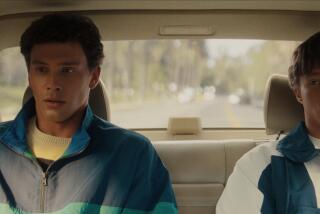Sleep Tight, a Monstrous Season Approaches : Movies: Those perennial masters of the dark, Frankenstein’s monster and Count Dracula, return in a pair of new films. As always, they keep changing with the times.
It is a cool fall evening, only minutes after the last glow of an afternoon sunset has faded behind the cloak of night, and as you sit in the darkness waiting, you hear them coming.
Leaves that were clinging to life just days ago now lay dead beneath the skeletal branches, crying out involuntarily as they are smashed under the feet of the approaching creatures. Soon, the leaves grow silent, and you know that the monsters are there, right there, outside your door, and that they will not go away until you have looked into their ghastly faces, and satisfactorily answered the eternal question:
“Trick or treat?”
Oh, yeah, it’s Freddy Krueger, or Jason, the Mummy or the Werewolf, maybe even the devil himself. If the entrepreneurial ghouls have their way, and parents in your neighborhood are tacky enough to let their kids wear them, it could be the mask of O.J. staring back at you. But if this Oct. 31 is like most others during the past six decades, ever since Hollywood got its voice and put the scream in Halloween, you are sure to be visited by the perennial masters of the dark, the id and the ego of the Living Dead, Frankenstein’s monster and Count Dracula.
*
If you’re really paying attention, the faces stamped out in latex are those of Boris Karloff and Bela Lugosi, whose performances in Universal’s seminal 1931 talking horror movies, “Frankenstein” and “Dracula,” set the images of the characters forever.
In the 63 years since “Frankenstein” and “Dracula” were released, there have been countless remakes, knockoffs, spoofs and parodies. There are 32 movies with Dracula in the title available right now on video, 29 with Frankenstein, and scores more featuring either those characters or monsters sporting similar MOs.
Frankenstein’s monster and the vampire who inspired Count Dracula were conceived in novels, illustrated in magazines, given life on stage, transported to the silver screen and broadcast over the airwaves. Their stories have been told and retold, their powers and personalities subjected to a thousand whims of reinvention. They flourished during the Great Depression, survived World War II (and Abbott and Costello), saw aliens from outer space, psycho-killers, and devils of every denomination come in and out of vogue. They have even survived face-to-face confrontations with each other, and, at the end of the day, remain the dominant figures of modern horror fiction.
And they are about to go after each other again, at least at the box office.
On Friday, TriStar opens “Mary Shelley’s Frankenstein,” directed by Kenneth Branagh and starring Robert De Niro as the monster. A week later, Warner Bros. trots out Neil Jordan’s “Interview With the Vampire,” with Tom Cruise playing the vampire Lestat.
As this is being written, there is no advance word on the comparative quality of the two films, but the smart money says the vampire movie will win the 1994 monster-off. Not just because Cruise is a bigger box-office star than De Niro, but because the prevailing social environment is more suited to the seductive wiles of vampires, and to the pleasures and dangers of sex, than to the raw terror of the walking dead and the theme of science run amok.
Let’s face it, Frankenstein’s monster, as we have come to know him in film, is an NFL lineman, a lumbering ox who is all scar tissue and brute force, trudging along without any supernatural, social or intellectual skills. Even though Shelley had him pining for a sweetheart, it’s hard to imagine what he’d have done with her.
In contrast, Dracula and his literary variants have been depicted as suave, sensual, alluring figures who move with the grace of the wind, and though they become petulant over the presence of garlic, crucifixes and mirrors, they remain relatively free of the constraints of nature.
As monsters, they seem to make strange bedfellows, yet they have sort of marched two abreast throughout 19th- and 20th-Century culture. They were, if legend has it right, even conceived on the same weekend in 1816, under the same roof, perhaps under the influence of the same drugs, in a villa near Lake Geneva, where Mary Shelley, her husband Percy Bysshe Shelley, Lord Byron and a Dr. Polidori got together to exchange ghost stories.
During that decadent house party, Shelley reportedly saw the image of a scientist reanimating a corpse in a dream, while Dr. Polidori began a story that would produce his 1819 novella, “The Vampyre.”
Shelley’s monster and Dr. Polidori’s vampire were conceived as sort of freakish peers, products of their own excessive environment. Though feminist writers have suggested that Shelley’s story was an allegory about the male desire to procreate without having to put up with women, she gave the more reasonable explanation that she was stimulated by theories of how electricity might be used to raise the dead.
In any event, the original monster that her Dr. Victor Frankenstein assembled from spare parts found in graveyards and morgues was an intelligent creature who, though he looked a fright, could function within society. He could speak several languages, and was driven not by some quest for spiritual light, like that big lug Boris Karloff played, but by anger and revenge, a desire to smash the godhead science that made him.
Dr. Polidori’s vampire was also a product of the author’s cultural background, a suave rake whose nocturnal lifestyle and perverse pleasures seem only a few degrees removed from the lives of some early 19th-Century aristocrats.
Bram Stoker, a product of the Victorian Era, scruffed up the vampire’s image and buried Polidori’s sexual imagery in his 1897 novel, “Dracula,” making the count a pasty, decrepit old man. He is about as seductive as a mosquito, a thief in the night, slipping into the boudoirs of sweet-blooded maidens, and feasting as they sleep.
The vampire became even more ghastly in F. W. Murnau’s 1922 silent movie, “Nosferatu,” an unauthorized adaptation of “Dracula,” featuring a rat-faced, long-eared Count Orlock.
Shortly after that, Hungarian actor Bela Lugosi combined some of the aristocratic bearing of Dr. Polidori’s vampire with the Transylvanian mystery of Stoker’s Dracula in a hugely successful stage production, then reprised it in Tod Browning’s 1931 movie, and the character, as he is most commonly known, was born.
That same year, Frankenstein’s monster underwent a personality change. Shelley’s story was too horrific for movie audiences trying to get used to the shock of people talking in movies, let alone screaming. And by then, mad scientists trying to play god seemed a realistic threat to rational people. So Universal turned the monster into a pure victim of science, the confused creation of a mad grave robber, who killed only by accident, or when threatened.
“Dracula” and “Frankenstein” launched a decade of horror movies in Hollywood, and spawned sequels--”Dracula’s Daughter” and “The Bride of Frankenstein”--considered today to be better than the originals. But the onslaught of competitive monsters, plus the advent of the atomic age, shunted the classics aside, or turned them into comic relief in “Abbott and Costello Meet Frankenstein,” or into gentle suburbanites in “The Addams Family” and “The Munsters.”
England’s Hammer Films made a series of blood-soaked but fairly faithful Frankenstein and Dracula movies in the ‘50s and ‘60s, and with the 1974 “Young Frankenstein,” Mel Brooks made what may be the best and most affectionate genre spoof in Hollywood history. But the monsters’ images could use some sprucing up, which is what they may be about to get.
Branagh’s version of the Frankenstein story hews closely to Shelley’s original story line, which has the monster murdering the doctor’s brother and wife and chasing him halfway around the world. And Jordan’s adaptation of “Interview With the Vampire” will be a major disappointment if it doesn’t capture the seductive atmosphere of Rice’s novel.
The oddity of the two subjects is that while “Frankenstein” began life as the philosophical work--a cautionary tale about man going against nature--and the vampire stories as pure horror entertainment, they have temporarily switched positions in the ‘90s. Even though man is tinkering with nature as he never has before, society is less panicked by what science might accomplish than by what it cannot.
The vampire stories, with their inherent linking of sexuality, blood and death, the mystery and power of the combination, make them seem as if they are allegories foretold. As ridiculous as things got in Francis Ford Coppola’s over-the-top 1992 “Bram Stoker’s Dracula,” it was impossible to watch the count’s infecting of Mina with his blood and not see it as a sign of the times.
There may come a time when the mad scientist reclaims his ranking as a fearsome menace--there are people out there we don’t want to see cloned, for instance--but for now, Dr. Frankenstein seems a benign threat, and his monster goes comparatively gentle into the night.
HALLOWEEN TREATS: Celebrate tonight with two horror classics. Please see Screening Room. F2
More to Read
Only good movies
Get the Indie Focus newsletter, Mark Olsen's weekly guide to the world of cinema.
You may occasionally receive promotional content from the Los Angeles Times.










